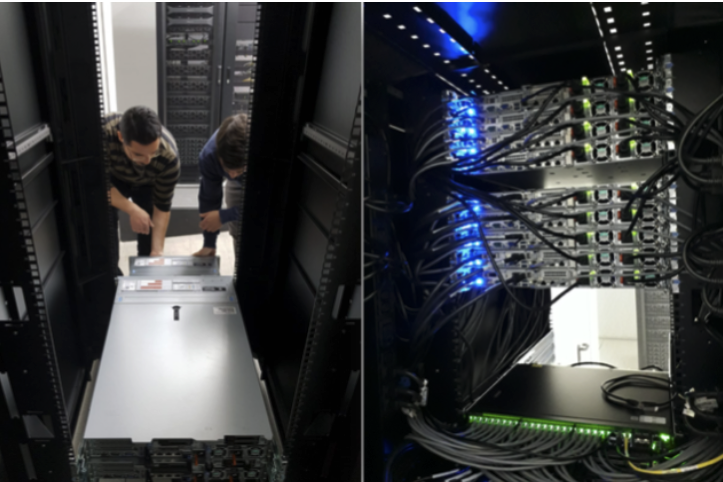Spain, a pioneer in the global network of SKA regional centres
The Spanish prototype of the SKA Regional Centre, developed by IAA-CSIC, becomes the first centre to successfully complete its integration into SRCNet0.1, the first operational version of the international network that will form the scientific core of the Square Kilometre Array Observatory (SKAO)
SKAO is an international organisation building two next-generation radio telescopes: SKA-Low in Australia, with more than 130,000 dipole antennas for transmitting and receiving radiofrequency waves, and SKA-Mid in South Africa, with 197 parabolic antennas, each 15 metres in diameter. Once operational, the observatory’s telescopes will generate over 700 million gigabytes of data per year. All this data will be stored in the SKA Regional Centres (SRCs), where it will also be accessible for remote processing. The various SRCs, distributed worldwide, will be interconnected, forming a global network known as SRCNet.
On Monday, 24 February, it was announced that the Spanish prototype of the SKA Regional Centre, currently under development at the Instituto de Astrofísica de Andalucía (IAA-CSIC), has become the first to complete the deployment and integration of the required services to join SRCNet0.1. This initial operational version of the international network will be essential for the functioning of the Square Kilometre Array Observatory (SKAO).
The Spanish SRC prototype, known as espSRC, is one of 17 national initiatives contributing to the development of SRCNet. "We have been working on this project since 2019, demonstrating our strong commitment to developing SRCNet as a collaborative platform. Being the first centre to deploy the necessary services to become a node of SRCNet0.1 is the result of this commitment and close collaboration with the other international teams involved," says Susana Sánchez-Expósito, technical coordinator of espSRC at IAA-CSIC. "We now have a fully functional system that has supported more than 30 scientific projects across different branches of astrophysics," she adds.
Isabel Márquez, Scientific Director of the Severo Ochoa Programme at IAA-CSIC, highlights: "This multidisciplinary approach makes the SRC prototype one of the key pillars of our scientific strategy, with a transversal character, and funded by our Severo Ochoa Excellence Project. Having such an infrastructure at our centre positions Andalucía and Spain within the international SKA collaboration."

Members of the Spanish SKA team setting up the servers of the Spanish SRC Prototype (2020). Credit: IAA-CSIC
Lourdes Verdes-Montenegro, IAA-CSIC researcher, Spanish SKAO participation coordinator, and espSRC lead, emphasises: "Sustainability and open science are among SKAO’s founding principles, and our prototype stands out as a reference in implementing both aspects within SRCNet." Open science is based on the principle of research reproducibility. According to UNESCO, this approach is increasingly recognised as a key driver for achieving the Sustainable Development Goals (SDGs). For this, it is essential that data, methods, and analysis tools are made available to society. "SKAO will change the way we do science: working locally on our computers will no longer be possible, and the SRCs will form the scientific core of SKAO, providing an environment that enhances and facilitates collaboration between international teams in line with the principles of open science," concludes Lourdes Verdes-Montenegro.
Animation showing the SKA data journey, from radio signals arriving at the SKA telescopes, through the various stages of processing, to the network of SKA Regional Centres which will take the data or astronomers around the world. Credit: SKAO
ABOUT SKA SPAIN
Spain is a member of the Square Kilometre Array Observatory (SKAO) and participates both scientifically and technologically. Its contribution is funded by the Ministry of Science, Innovation and Universities, while the national scientific and technical coordination of the project is led by the Instituto de Astrofísica de Andalucía (IAA-CSIC), which acts as the Spanish SKA Office, organising the Spanish scientific community’s participation in the project. Additionally, the Centre for Technological and Industrial Development (CDTI) is responsible for promoting Spanish industry’s participation in SKA developments.

Composite image of the SKA telescopes, blending real hardware already on site with artist's impressions. From left: An artist's impression of the future SKA-Mid dishes blend into the existing precursor MeerKAT telescope dishes in South Africa. From right: An artist's impression of the future SKA-Low stations blends into the existing AAVS2.0 prototype station in Western Australia. Credit: SKAO
- Lourdes Verdes-Montenegro - lourdes@iaa.es
- Susana Sánchez Expósito - sse@iaa.es
- Instituto de Astrofísica de Andalucía (IAA-CSIC)
- Unidad de Divulgación y Comunicación
- Amanda López – alm@iaa.es
- Emilio García – garcia@iaa.es - 649 407 445 (vía whatssap)
- Celia Navas - navas@iaa.es
- https://www.iaa.csic.es
- https://divulgacion.iaa.csic.es

